Intel SSD 520 Review: Cherryville Brings Reliability to SandForce
by Anand Lal Shimpi on February 6, 2012 11:00 AM ESTRandom Read/Write Speed
The four corners of SSD performance are as follows: random read, random write, sequential read and sequential write speed. Random accesses are generally small in size, while sequential accesses tend to be larger and thus we have the four Iometer tests we use in all of our reviews.
Our first test writes 4KB in a completely random pattern over an 8GB space of the drive to simulate the sort of random access that you'd see on an OS drive (even this is more stressful than a normal desktop user would see). I perform three concurrent IOs and run the test for 3 minutes. The results reported are in average MB/s over the entire time. We use both standard pseudo randomly generated data for each write as well as fully random data to show you both the maximum and minimum performance offered by SandForce based drives in these tests. The average performance of SF drives will likely be somewhere in between the two values for each drive you see in the graphs. For an understanding of why this matters, read our original SandForce article.
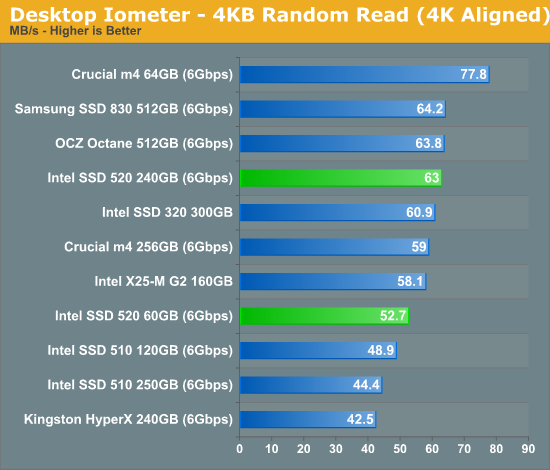
Random read performance seems to have topped out around 60MB/s for most drives and the 520 is no different here.
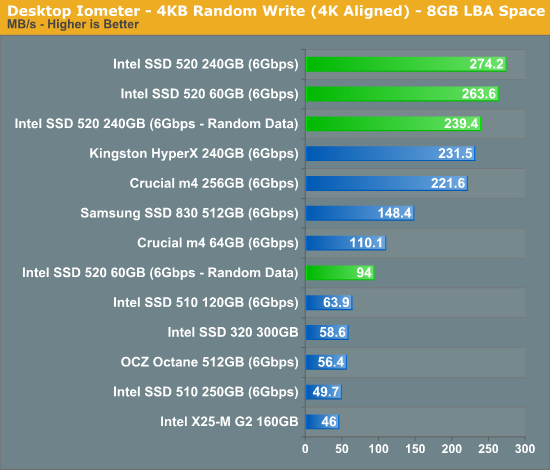
Random write performance, especially with highly compressible data sets the 520 performs beautifully - even outpacing the SF-2281 based Kingston HyperX.
Many of you have asked for random write performance at higher queue depths. What I have below is our 4KB random write test performed at a queue depth of 32 instead of 3. While the vast majority of desktop usage models experience queue depths of 0 - 5, higher depths are possible in heavy I/O (and multi-user) workloads:
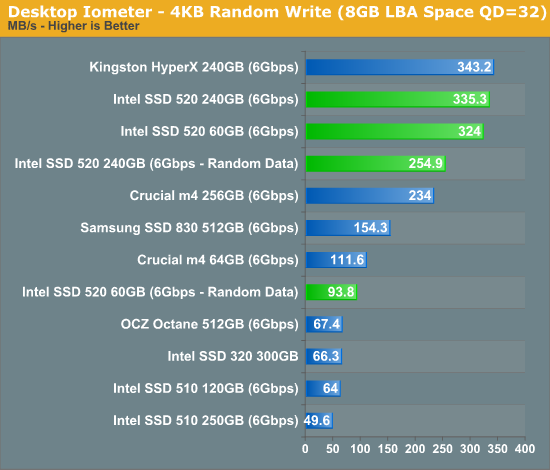
At higher queue depths the HyperX catches up to and surpassed the 520, perhaps indicating that Intel has done some work to optimize low queue depth performance on the 520 (likely what most end users will encounter).
Sequential Read/Write Speed
To measure sequential performance I ran a 1 minute long 128KB sequential test over the entire span of the drive at a queue depth of 1. The results reported are in average MB/s over the entire test length.
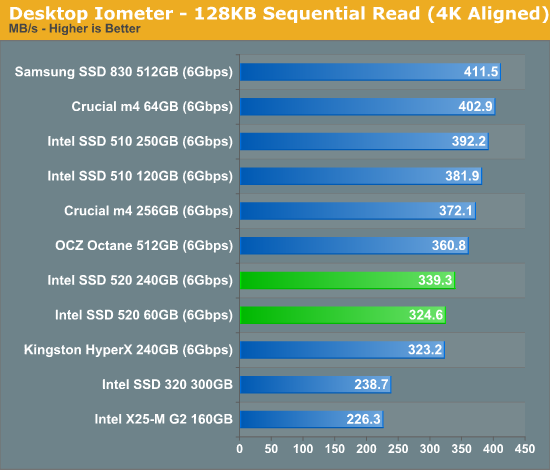
Sequential read performance is actually a bit lower than Intel's 510, but still higher than a standard SF-2281 drive.
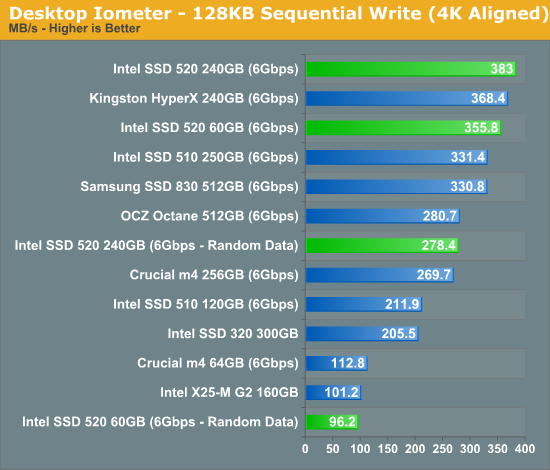
It's important to note just how close the 520's peak random write performance is to its sequential write performance. A big part of this is obviously that the SF-2281 is throwing away a lot of the data it has to write, but even if we compare incompressible 4KB random write to highly compressible 128KB sequential write we see a good ratio. The closer those two values are the more optimal the controller/firmware design is as, in theory, smaller random writes should be grouped to effectively become large sequential writes from the perspective of the NAND.










138 Comments
View All Comments
frank1985 - Monday, February 13, 2012 - link
I am a customer of this guy, and I had to return my $240 Corsair Force 2 drive/paperweight *11 days* after purchase (at which point I traded it in for his old OCZ Vertex2 which has been running without issue).Like Iketh, the fact that you can't recover performance with TRIM is a showstopper for me. I'm going to stick with the 320 series drives - they might be slower, but TRIM does what it's supposed to.
Wolfpup - Monday, July 23, 2012 - link
The TRIM issue worries me too. Sounds like it's even worse than on Micron/Crucial's M4?My 320's been great, though annoyingly the 600GB version is MASSIVELY more than the 480GB 520, or the 512GB M4...possibly because of this issue?
Ratman6161 - Wednesday, February 8, 2012 - link
I have an OCZ drive based on the SF22xx. For the first month it was nothing but trouble. Then with the release of the 2.15 firmware, suddenly all the problems went away like magic. It could simply be that OCZ paid the price for being early adopters and released to the market a product that really should have been a Beta version. Now that it has the firmware that it should have had from the beginning, everything is fine.Intel has waited until the product is more mature so its no surprise they aren't seeing these problems
Wolfpup - Monday, July 23, 2012 - link
Did you read the article? Intel explicitly fixed problems still present in other firmware.ckryan - Tuesday, February 7, 2012 - link
The Samsung 830 is maybe the finest consumer drive released in all of 2011. There is no shame in going Samsung, and in my mind, it's a fine alternative to almost every drive out there.Samsung and Micron probably have to wonder how Intel gets all the press about their NAND being better. As far as I can tell, Samsung's 27nm Toggle in the 830 is pretty damn good. The Micron NAND used in Micron's own drives is fantastic, and of course Intel's top shelf NAND is good too. But only Intel gets the press for having excellent NAND in it's own drives.
I don't think enough emphasis is placed on the NAND. You can't get a clear picture of NAND quality through benchmarking.
krumme - Monday, February 6, 2012 - link
Exit Intel from the controller market. No wrapping in reliability, as rightfully as it is, can change that fact seen from here.Anyway, Intel can earn on the memory, as was probably the plan from day 1. We will see how profitability is here in 5 years time.
tipoo - Monday, February 6, 2012 - link
I still get a kick out of how a relatively tiny startup company makes better performing parts than the chipzilla that is Intel. Good call working with them.Makaveli - Monday, February 6, 2012 - link
What I think you are missing is that Intel doesn't because they don't have to or care to. Intel is a huge company with equally big profit margins to maintain for their shareholders. The SSD market is still a small compared to the other things they dabble in. And yes they produced a controller in the past but I don't think the Money and R&D was worth it for them to continue based on the profits needed to keep them interested. We already know they make a ton of money selling nand as is.So to sum it up they could easily put out a controller that would be superior but just don't care too at the moment.
Kevin G - Monday, February 6, 2012 - link
Intel's plan was to gain control of the entire SSD product: from flash (joint venture with Micron), to the controller and to the firmware. It does appear that their original plan has fallen apart due to delays with their custom controllers which has forced them to use 3rd party controllers.I wouldn't say that Intel has stopped investing into developing their own controllers though. Intel can offer a level of integration that no other vendor can offer: direction integration into an x86 SoC. I strongly suspect that the successor to Haskwell and future Atom SoC will come with a direct ONFI connectivity backed by an internal Intel controller.
At that point in time, I suspect that SSD controllers will become akin to what discrete GPU's are today: a midrange or high end item for consumers.
NitroWare - Wednesday, February 8, 2012 - link
People forget Intel was one of the innovators in bringing MATURE Flash to consumer technologies.Intel Desktop and OEM motherboards have used their surface mount flash chips for PC BIOS since 1996. This setup provided a recovery mode to get out of BIOS corruption. To this day, excluding motherboards with dual BIOS no motherboard has the same robust recovery system as Intel boards do.
If the recovery mechanism fails then there is a more serous failure anyway.
At the time other vendors were still using older DIP socket EEPROM and some still do now , only changing to serial format ROM.
Even for current ASUS Flagship ROG boards, the best failsafe they offer is a socketed BIOS.
Intel offered those Turbo Boost Flash cards several years ago for the 1156 motherboards and laptops which did not take off. They also championed Hybrid HDD for portables.
So I think Intel know what they are doing with solid state, but yes eventually the technology will become commodity